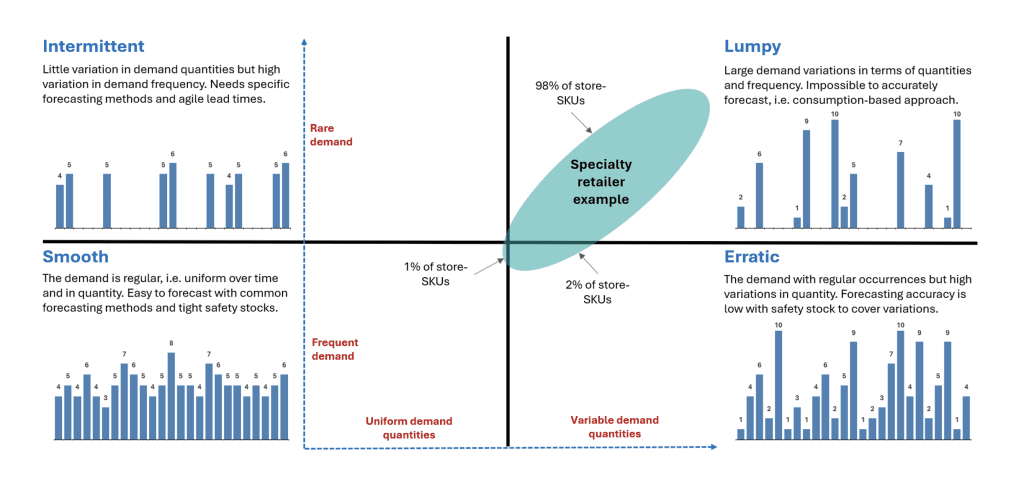


Poor forecasting is costing retailers millions in lost sales and loyalty: here’s how to solve it.
Nothing frustrates shoppers more than finding empty shelves where their favourite products should be. Yet, the impact of stock-outs on a retailer’s bottom line is greater than many realise. When products aren’t available, up to 43% of shoppers will go elsewhere and these abandoned purchases translate into lost sales of about 4% for a typical retailer. To put that into context, for a billion-dollar retailer, that’s the equivalent of £40 million in lost sales every year.
So why is forecasting so difficult and what should retailers be doing differently?
Avoid standardised forecasting
On the surface, it’s easy to see why retailers choose this route. It simplifies decision making and potentially reduces data science costs. But here’s why it won’t work. Standardised forecasting algorithms and replenishment policies don’t account for the granular reality of store and SKU-level demand.
It also can’t account for fluctuations in stock based on the weather – which is increasingly hard to predict or boosts from events. Case in point: the Taylor Swift effect where her concerts led to unexpected retail spend boosts in the host city and surrounding areas.
Instead, planners aggregate forecasts across multiple stores or distribution centres (DCs). While this approach makes sense for procurement, it does little to ensure that individual SKUs are available when and where shoppers want them.
To complicate matters further, many retailers rely on weekly replenishment cycles. This often means that critical daily demand fluctuations – especially for promotions and new product launches – go unnoticed.
Don’t base assumptions on store-SKU level demand
Daily store demands are incredibly hard to predict. Retailers often assume that most of their sales fall into a ‘smooth’ demand pattern – steady and predictable, like milk in a supermarket. However, the reality is that a staggering proportion of retail demand is highly variable. A typical demand classification framework divides products into four categories:
- Smooth demand – frequent sales with little variation (e.g., milk, bread).
- Intermittent demand – infrequent sales but relatively consistent quantities.
- Erratic demand – frequent but unpredictable fluctuations in quantity.
- Lumpy demand – sales that are both infrequent and highly variable.
For speciality retailers, nearly all daily demand falls into the lumpy category. In the broader CPG sector, up to 86% of SKUs and 52% of revenue comes from lumpy demand, making it just as important as the the fast-moving products retailers typically prioritise.

Don’t expect AI or legacy systems to solve the problem
Most inventory management systems such as ERPs, demand planning software, or even AI-driven forecasting are based on assumptions that fail when applied to lumpy demand. Here’s why:
- They assume demand follows a normal distribution, but lumpy demand is often skewed.
- They rely on traditional time-series forecasting models, which don’t work well when demand is unpredictable.
- AI struggles without additional data signals, because past sales alone are a poor predictor of future demand.
Retailers often turn to statistical models designed for intermittent demand, such as Croston’s method, SBA, or TSB forecasting, but these methods still fall short when demand varies across frequency and size. Even Amazon, one of the most sophisticated supply chains in the world, acknowledges that no model can perfectly predict customer demand.
Adding to the complexity, forecast accuracy is further distorted by real-world constraints—minimum order quantities, pallet and lorry load considerations, and storage limitations. The perfect demand forecast is meaningless if execution constraints prevent retailers from acting on it.
Shift from Forecasting to Agile Replenishment
With $349 billion in lost sales in North America alone due to inventory distortion, it’s time for retailers to rethink their approach. Instead of asking, “What will future demand be?”, they should focus on “Which SKUs do we need, and how do we ensure availability?”
This means moving beyond forecasting accuracy and towards understanding demand variability, incorporating factors like:
- Size and frequency of demand fluctuations at the store level.
- Seasonality, pricing, and promotions that impact sales.
- Balancing inventory holding costs with lost sales risk.
To bridge the gap between demand unpredictability and product availability, agile replenishment models are gaining traction. Depending on store density and SKU mix, retailers can implement:
- Hub-and-Spoke Replenishment – A central ‘hub’ store holds stock and supplies nearby stores with same-day deliveries.
- Store-to-Store Rebalancing – Excess stock in one location is dynamically redistributed to stores experiencing shortages.
- Relay Point Replenishment – Inventory is relayed through urban transfer points, allowing smaller vehicles (e.g., e-cargo bikes) to optimise last-mile delivery.
The most advanced retailers combine multiple models based on geography and product mix, ensuring greater availability while keeping replenishment costs under control.
Want to Reduce Stock-Outs and Improve Revenue?
Retailers need to accept that some demand will always be unforecastable but that doesn’t mean they have to accept lost sales. By adopting smarter demand classification, agile replenishment strategies, and better inventory planning, businesses can reduce stock-outs, increase revenue, and improve the shopper experience.
Although the complexity of demand planning can’t be ignored, the good news is that even a 2% improvement in on-shelf availability can increase sales by 1%. And while that might seem small, in an industry where every percentage point counts, it can add a sizeable impact on margins. At RideLogix, we specialise in helping retailers optimise inventory availability with rapid inventory health diagnostics and tailored replenishment strategies to improve stock availability and recover lost revenue.

